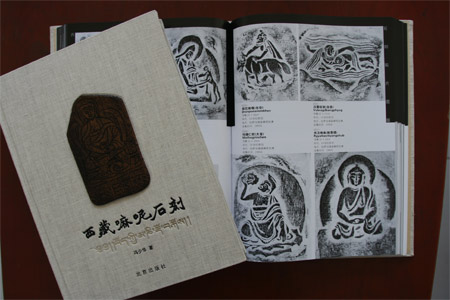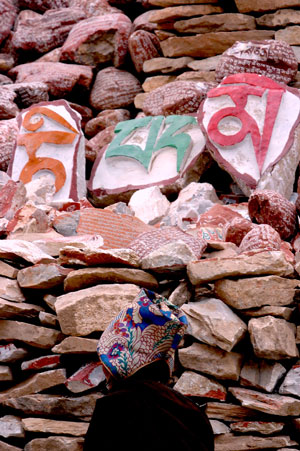Book on Mani stone carving published
2009-09-28 17:50 BJT
BEIJING, Sept. 3 -- A book illustrating the religionary and sacred Mani stone craving in Tibet was published on Tuesday.
The book, titled "Tibetan Mani Stone Carving," totals some 300,000 characters and has 949 pictures. Published by the Beijing Publishing House, the book was written by Feng Shaohua, a veteran editor of Jinan Daily, who worked in Tibet for 13 years.

A book illustrating the religionary and sacred Mani stone craving in Tibet was published on Tuesday. (Xinhua Photo)
Mani stones are stone plates, rocks or pebbles inscribed with the six syllable mantra of Avalokiteshvara as a form of prayer in Tibetan Buddhism.
Such stones are usually placed primarily by Tibetan Buddhist followers along the roadsides and rivers or placed together to form mounds as an offering to spirits of place.

A woman of Tibetan ethnic group passes by the Mani Stone Mound in Xinzhai Village, Yushu County, Tibetan Autonomous Prefecture of Yushu, northwest China‘s Qinghai Province, on March 24, 2009.(Xinhua/Yang Shoude)
Creating and carving mani stones as a devotional or intentional process art is a traditional way of showing Tibetan Buddhist believers‘ piety to the religion.
Fond of Mani carving, Feng was rapt in studying and collecting the carvings and once visited some remote areas during his stay in Tibet.
The book has filled the void in research on Mani carving, and also becomes a useful reference for the research and development of Tibetology, said Wu Junkui, consultant of the book.
In particular, he added, it offers tourists and people who are interested in Tibet a gate to the ancient and mysterious Tibetan culture and art.
Editor: 卢佳颖 | Source: China Tibet Information Center

 Mail
Mail Share
Share Print
Print


 Video
Video









 2009 China Central Television. All Rights Reserved
2009 China Central Television. All Rights Reserved